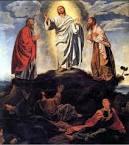
Richard Dawkins, and many atheists like him, demand physical evidence for anything to be accepted as fact. Spiritual experiences however, by their very nature, go beyond the empirical to something that is more deeply real but cannot be proved scientifically. St Paul’s vision of Jesus on the road to Damascus dramatically changed his life in a few short moments. Many of us have had experiences which have determined the course we chose to take.
The three disciples Peter, James and John were led up a mountain. High places in Hebrew thought symbolised closeness to God: Moses had received the Ten Commandments on Mount Sinai, and Elijah encountered the Lord on Mount Horeb. The disciples knew that Jesus was someone very special but he functioned as an ordinary human being like themselves, and he had previously lived a unobtrusive life in Nazareth as the village carpenter. Now, however, a veil was being lifted and they were encountering their master and friend in his glory in what was like a preview of the Trinity, with the Father’s voice acclaiming his Son. It was as though God’s plan of salvation was being laid before them, with the appearance of significant figures from their scriptures, through whom God had worked, till the coming of the promised Messiah. The consolation of that vision must have sustained them and helped them to sustain their fellow disciples in the dark days when their Lord, whom they had seen in majesty on the mountain, was raised high again but this time on a cross, horribly disfigured, executed as a common criminal.